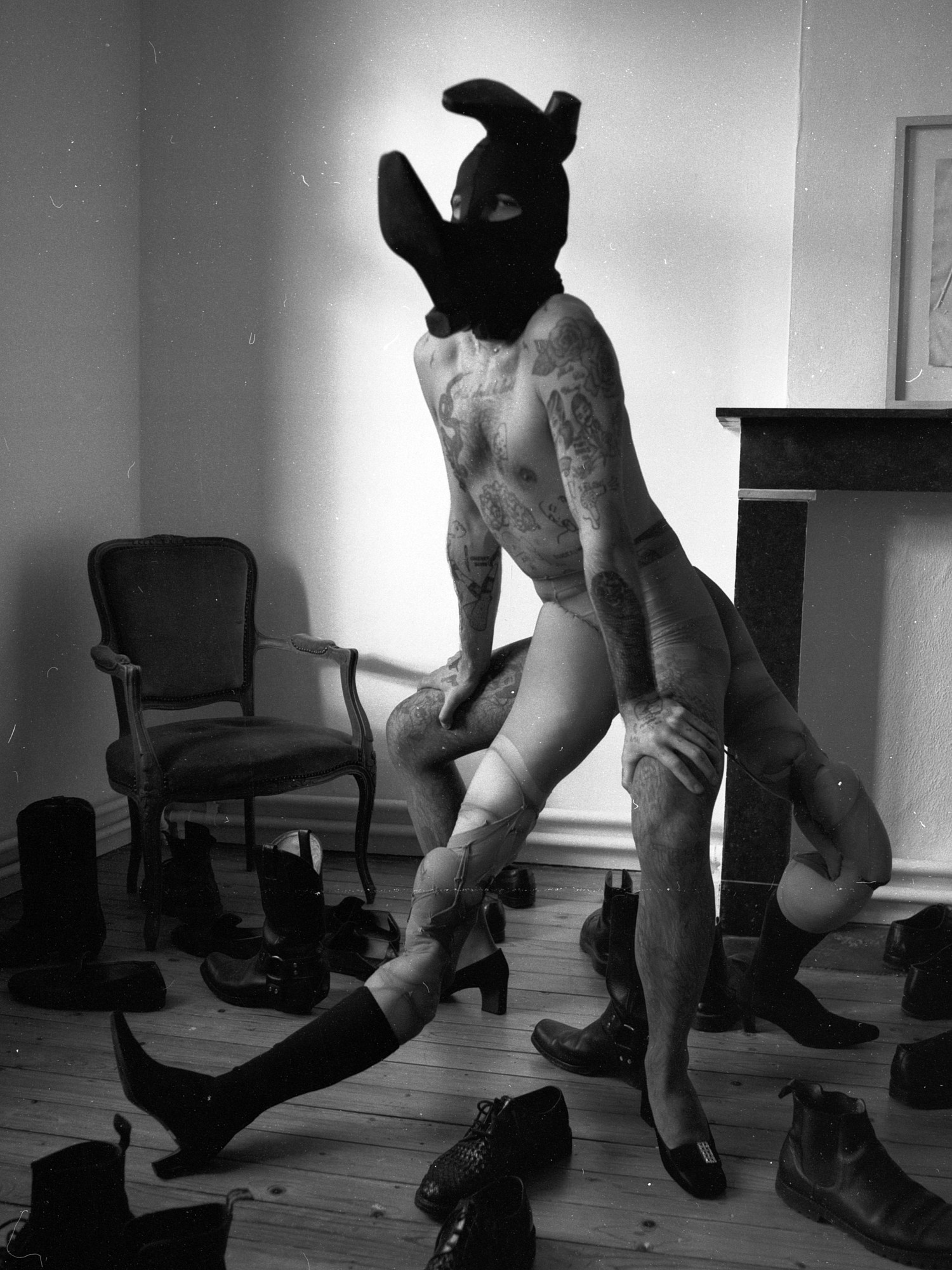Inspiration from the fetish-scene has been a solid undercurrent in the fashion industry for decades. Vivienne Westwood sold bondage gear to the punks in the seventies, Thierry Mugler’s outrageous creations in the 80s and 90s almost without exception had a dominatrix-energy going and the 1992 Versace S&M-dress is a staple in the wardrobe of every self-respecting celebrity.
Now, once again, fetish has come out of the dungeon and onto the catwalks. Last year, Louis Vuitton’s glittered-up harnesses made their way from the sex-party to the award show, worn by stars like Timothee Chamelet and Michael Jordan. More recently, Diet Prada made a nice fetish-overview of the latest fashion weeks. Balmain had their brown latex suits which fitted Kim Kardashian like a glove. Marni and Stella McCartney had the fluffy rabbit heads that used to belong to the territory of the furry-scene.
At Saint Laurent, Anthony Vaccarello combined three different fetish-y aesthetics in one look: rubbery sex pants, a silk scarf for a hint of asphyxiation and, of course, a fur coat — the most classic fetish-item, and the ultimate kink of the founding father of masochism: Leopold Ritter von Sacher-Masoch. The models looked classy in the shadows and film-noiresque searchlights. It was slightly erotic, but it certainly didn’t have much to do with dark fantasies.
Fetish, evidently, has been dragged out of the realm of sex into the realm of chic. It is more visible and socially acceptable than ever. How long will it take before latex pants become so mainstream that they are not associated with sex anymore, but with sticky, sweaty, weird smelling days at the office?
Probably some time, because of the current pandemic the world is dealing with. Offices are canceled (so we don’t have to wear pants while working), most fashion-events are canceled, and so is parading on the streets in general. A nightmare for the fetish-flâneur. On the plus side, however, all these restrictions offer us a way to rediscover what fetish really means in a private setting, beyond the trendy aspect of it.
As we speak, this is already happening. Shalva Nikvashvili, the Georgian artist known for his haunting masks is now working from home with his husband Sascha Bewersdorff, and they created what could be interpreted as a hybrid between pup-play and shoe-fetish. With a few months left to experiment, whole new aesthetics might emerge out of people’s isolation.
An example of what can happen when restrictions force people to rediscover their fantasies can be found in the work of Jan Švankmajer. The Czech film-maker (who’s almost complete oeuvre was shown last year in the Amsterdam film museum Eye) wasn’t restricted by an epidemic, but by the totalitarian communist regime: in the late 70s he was banned from making his stunning animated films.
When his visual arts were censored, Jan started experimenting with a sense that had been largely neglected in the arts up till that point: touch. In the introduction of his 1977 book Touching and imagining he makes clear that he has completely accepted the challenge to explore other dimensions than the visual one. He writes that “our sight is being corrupted on an unimaginable scale” as “daily it is drowned and blunted by a flood of the most banal consumerist culture”. Jan explains how tactility had been a subject in western visual art, but that art created only in order to be touched didn’t really exist yet. After joining the Prague Surrealist Movement, he started making exactly that, guided by his personal obsessions and fantasies.
First, he constructed artworks from ceramics that were covered with cloth afterwards, allowing people to write accounts of their associations while touching the work. Later, he started using other household objects, like water taps, pieces of bone, empty cans, glass ashtrays and iron wire, to make the tactile art even more exciting. He also created a ‘bondage chair’ (called “The slavery of utilitarianism”) with brushes on the seat and fur and cheese graters on the back, and wrote the rules for tactile games. Like the chair, these games also have something erotic to them, as they involve things like walking naked over sandpaper in a darkened room. We must note that Jan often worked closely together with his wife Eva, with whom he had such a spiritual bond that he made drawings inspired by her ghostly presence after she died.
If you are sick of looking at your own interior, porn and the endless stream of corona-news, it might be time to turn off the lights and start discovering the (especially in these times of social distancing and insta-only events) largely ignored senses of touch and imagination. Maybe fetish will look and feel completely different when the lights go on after this quarantine-crisis — that would be truly subversive. And of course, we’ll probably see that reflected on the catwalks, whenever there will be catwalks again.
